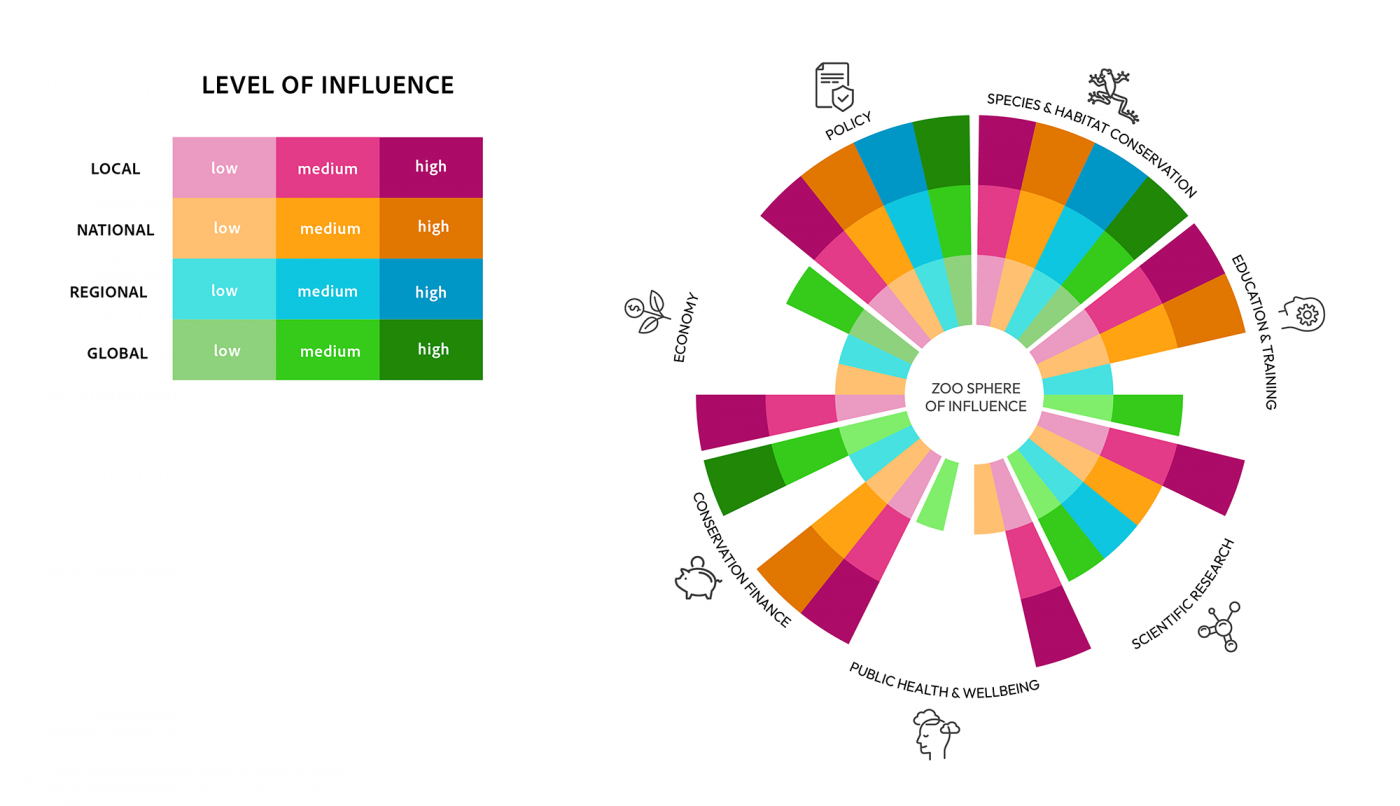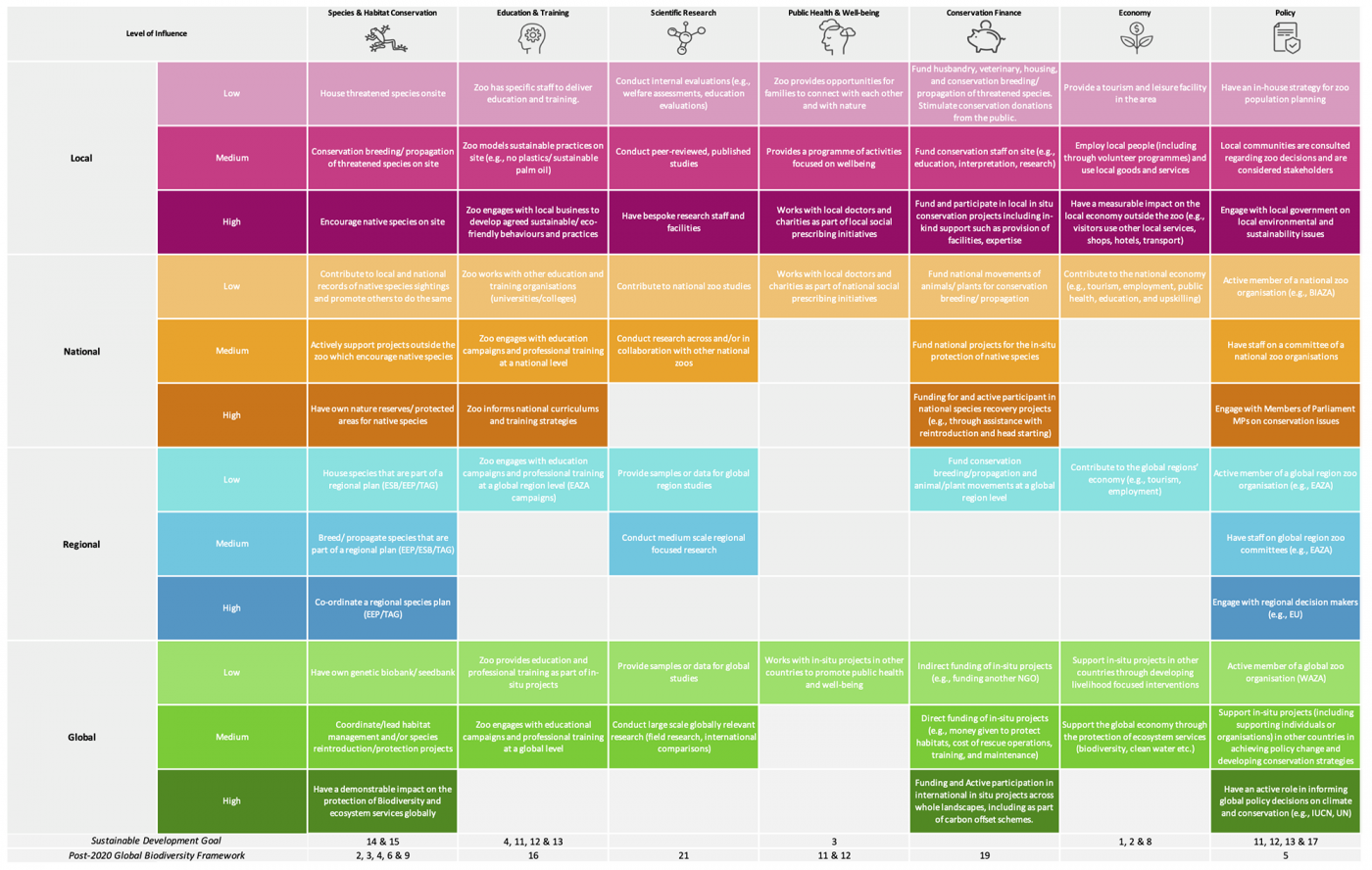Understanding the role of zoos
For the past 50 years the role of zoos has been understood as conservation, education, recreation and research. However, this no-longer reflects the broad spectrum of services that conservation zoos and aquariums now provide.
A recent paper by our in-house conservation scientists, published in Biological Conservation, demonstrates a new holistic way of viewing zoos’ role for species and society.
In this new ‘Sphere of Influence’ model, zoos are depicted at the centre of a web of activities including species and habitat conservation, education & training, scientific research, public health & wellbeing, conservation finance, economy, and policy.
“Good zoos and aquariums are powerhouses of conservation. They are playing a vital role in preventing extinction and restoring nature. The paper sets out a new model that could be invaluable for demonstrating the value of conservation zoos to everyone.”
Dr Jo Judge, CEO of BIAZA
Unlike previous ‘pillar’ representations of zoos’ role, this model reflects the interconnectedness of zoo work as part of an integrated species conservation or ‘One Plan’ approach. This recognises that zoos can influence at an international level and not only within their local area. The model demonstrates how influential a zoo is and whether it is achieving impact at a local, national, regional (international region such as Europe), or global scale.

Conservation through collaboration
The new Sphere of Influence model, and its accompanying assessment matrix, are important as they enable zoos to evaluate their conservation achievements and understand how zoos can better collaborate to ensure all potential conservation areas are covered. This also enables zoos to evidence their role as effective conservation organisations.
This assessment matrix will be developed further through focus groups and is eventually anticipated as an interactive tool whereby individual zoos and aquariums can visualise their own strengths and areas for improvement.
“To recover our planet’s wildlife and wild places we need to look afresh at the many roles we all play. We welcome this new model which reflects the wide range of ways in which good conservation zoos are contributing to, and driving, these efforts.” Dr Kira Mileham – Director, IUCN SSC Strategic Partnerships
Seven areas of influence
The model is currently divided into seven wedges to reflect the areas that conservation zoos and aquariums work in.
1- Species and Habitat Conservation
Zoos have the potential to influence at all levels (local- global, low-high) in this category. Roles include (but not limited to):
- Conservation Breeding
- Population Management and ensuring sustainable future populations.
- Habitat Management
- Reintroduction and head-starting
2 – Education & Training
Through educational and training programs zoos have an influence locally and nationally. Regional and Global influence is achieved through international conservation training programmes. Education and Training includes:
- Formal school sessions
- Informal visitor learning
- Educational outreach
- Student research and training projects
- Training conservationists locally and further afield
3 – Scientific Research
Zoos are valuable locations for research as they provide real-world application of techniques and as research is needs driven. Research areas are wide ranging and include:
- Veterinary
- Welfare
- Reproduction
- Plant sciences
- Social Sciences
- Animal and human behaviour studies
- Genetic analysis and biobanking
- Endocrinology and disease research
4 – Public Health & Wellbeing
As a protected green space, often located in or near densely populated urban areas, zoos have an important role in public health and wellbeing. There is growing evidence to suggest that nature-based locations, including zoos have a positive impact on mental health and physiological responses.
- Zoos offer connection to nature.
- Zoo sites are blue/green spaces often located in urban areas.
- Increasingly, zoos offer specific programmes to promote positive well-being.
- Volunteering programmes offered by zoos have been shown to promote key skills development.
- Zoo field programmes have the potential to support global health initiatives.
5 – Conservation Finance
Through donations and revenue zoos can contribute financially to conservation.
- Zoos directly fund conservation projects,
- Provide in-kind conservation support such as educators, lawyers, scientists,
- Fund integrated species conservation, including resources for conservation breeding, research, and all aspects necessary to ensure the conservation of species,
- Support carbon credit schemes or other offsetting initiatives
6 – Economy
The role zoos fulfil as part of the economy is not insignificant.
- Zoos provide a tourist destination.
- Zoos employ local people and services.
- Zoos bring visitors into an area.
- Through the protection of habitats and species, zoos protect ecosystem services which provide natural and economic capital.
7 – Policy
The expertise zoos provide in a wide range of areas, not only as conservation centres but also as businesses, makes them well placed to advise sustainability and conservation policy.
- Zoos have worked with politicians to successfully introduce a no deforestation standard by the International Round Table on sustainable palm oil (RSPO 2018).
- Zoos have spearheaded campaigns to encourage local businesses to engage in more sustainable practices, e.g., The Deep aquarium leading a campaign to stop the use of plastic straws in the city of Hull, UK
- Zoos are increasingly involved in the formulation of international treaties and in meeting global targets such as the Global Biodiversity Framework and Sustainable Development
The role of individual zoos and aquariums
While not every zoo can complete all sections of the model on their own, they still play an important conservation role as part of the zoo community. Zoos that lack strengths in some areas, often have specialisms in others. For example, many house genetically unique individuals, critical to conservation breeding programs. By collaborating and sharing expertise, zoos can achieve integrated species conservation, address global conservation issues, and prevent species extinction.




